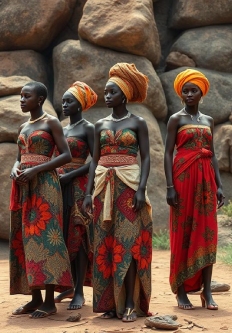The fashion world is a great mirror to see a reflection of the social, emotional, and historical journey of women. As they tried to find their voice in deeply patriarchal societies, their clothing became a tool of self-expression and liberation.
Casual fashion observers and professionals will know that dressing can tell a story of adaptation and elegance. Read on as we explore how women’s unmistakable mark on the fashion world.
Early Human Civilizations to the 20th Century

In the ancient world, a woman's dress mainly depended on the climate of her society, culture, and social class. In tropical early African societies, women wore wraps made from animal skins, bark cloth, and raffia. As weaving techniques evolved, women began to wear cotton fabrics, often paired with adornments such as shells and beads.
In early African cultures, unmarried women were known to wear simpler skirts, while married ones wore full-body wraps. In temperate pre-medieval Europe, women wore long dresses, often layered with shawls or cloaks.
Linen was the most common clothing material due to the cold climate. However, it wasn’t uncommon for women to wear wool. Wool and linen remained popular clothing materials for females in the Roman Empire. However, higher-class women began to import silk materials with intricate embroidered patterns and rich, vibrant dyes.
In the medieval era, women in Europe wore dresses that consisted of multiple layers, including an underdress, an overdress, and a surcoat. For most of human history, up until the 20th century, women's fashion was more about social rank and respectability than freedom. Moreover, females had no personal or bodily autonomy.
The 20th Century to World War 2
The beginning of the 20th century was a massive turnaround for women’s rights. Women began to join the workforce in significant numbers and started participating in sports. They began to ditch the heavy, overflowing dresses for fitted tops and trousers.
During the suffragette movement in the United Kingdom, women utilized the power of color to support their cause. For example, purple and white stood for loyalty and purity, respectively. World War 1 also meant that women had to wear practical clothing as they worked in the factories to support the men on the front lines.
World War 2 to the End of the 20th Century
World War 2 normalised pants and uniform for women. After the war, women were forced to head back to their domestic roles as homemakers. However, the invention of the contraceptive pill and the ensuing sexual revolution in the 1960s marked a new turn in women's fashion.
Mary Quant invented the miniskirt, and women incorporated this new piece of clothing into their clothing collections, often pairing it with trousers. France, in particular, became the epicenter of global women's fashion design.
In the 1970s, power dressing emerged as a prominent trend as women entered the workforce in large numbers. Blazers, suits, skirts, and jackets gave ladies a more professional and masculine look.
Designers like Yves Saint Laurent invented tailored tuxedos for women. Madonna was known for provocative dressing in rebellion against the traditional norms of the times. Brands like Balenciaga and Dior were also at the forefront of ladies' fashion styles.
From the End of the 20th Century to the Modern Day
The rise of the internet and other digital technology platforms greatly impacted the world of women's fashion. With the ability to interact via social media and watch celebrities on reality TV shows, female teenagers and older women are embracing elegance, comfort, and body positivity.
Pop musicians like Britney Spears and Christina Aguilera popularised crop tops and low-rise jeans. Social media platforms have given women the ability to express their fashion sense, regardless of their body shape, race, or cultural background.
Final Thoughts
The link between women's empowerment and fashion is undeniable. In the ages past, women wore whatever was imposed on them by their societal upbringing. Today, women’s fashion is more about beauty, resilience, identity, and self-expression.